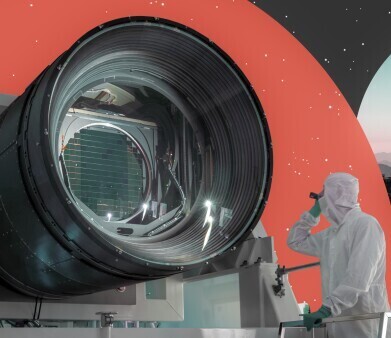News
SLAC celebrate completion of largest digital camera ever built
May 23 2024
Scientists and engineers at the Department of Energy's SLAC National Accelerator Laboratory along with their collaborators are celebrating the completion of the Legacy Survey of Space and Time (LSST) Camera which, from its place atop a telescope in Chile, will help researchers observe our universe in unprecedented detail.
As the heart of the DOE and National Science Foundation funded Vera C. Rubin Observatory, the 3,200-megapixel camera, roughly the size of a small car and weighing around 3,000 kilograms (3 metric tons), is the largest ever constructed for astronomy - and at five feet across the front lens is also the largest ever made for this purpose. Another three-foot-wide lens was specially designed to maintain shape and optical clarity while also sealing the vacuum chamber that houses the camera's enormous focal plane. Made up of 201 individual CCD sensors, the focal plane is so flat that it varies by no more than a tenth the width of a human hair. The pixels themselves are only 10 microns wide.
The camera will generate data on the southern night sky that will aid in the quest to understand dark energy, which is driving the accelerating expansion of the universe; and the hunt for dark matter, the mysterious substance that makes up around 85% of the matter in the universe. The Rubin data will also support better understanding of the changing night sky, the Milky Way galaxy and our own solar system.
“With the completion of the unique LSST Camera at SLAC and its imminent integration with the rest of Rubin Observatory systems in Chile, we will soon start producing the greatest movie of all time and the most informative map of the night sky ever assembled,” said Director of Rubin Observatory Construction and University of Washington professor Zeljko Ivezic.
The camera's most important feature is its high resolution; “Its images are so detailed that it could resolve a golf ball from around 15 miles away, while covering a swath of the sky seven times wider than the full moon. These images with billions of stars and galaxies will help unlock the secrets of the universe,” said SLAC professor and Rubin Observatory Deputy Director and Camera Program Lead Aaron Roodman.
Kathy Turner, program manager for the DOE's Cosmic Frontier Program added: "More than ever before, expanding our understanding of fundamental physics requires looking farther out into the universe."With the LSST Camera at its core, Rubin Observatory will delve deeper than ever before into the cosmos and help answer some of the hardest, most important questions in physics today.”
More information online
Digital Edition
ILM 50.2 March 2025
March 2025
Chromatography Articles - Effects of small deviations in flow rate on GPC/SEC results Mass Spectrometry & Spectroscopy Articles - Waiting for the present to catch up to the future: A bette...
View all digital editions
Events
Mar 31 2025 Beijing, China
Microbiology Society Annual Conference 2025
Mar 31 2025 Liverpool, UK
Apr 01 2025 New York, USA
Apr 02 2025 Saigon, Vietnam
Apr 09 2025 Tokyo, Japan




















